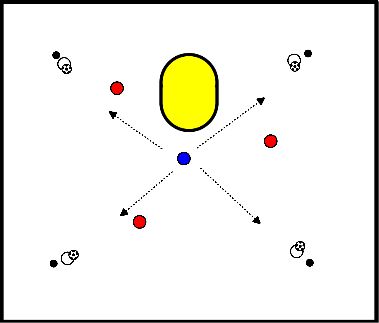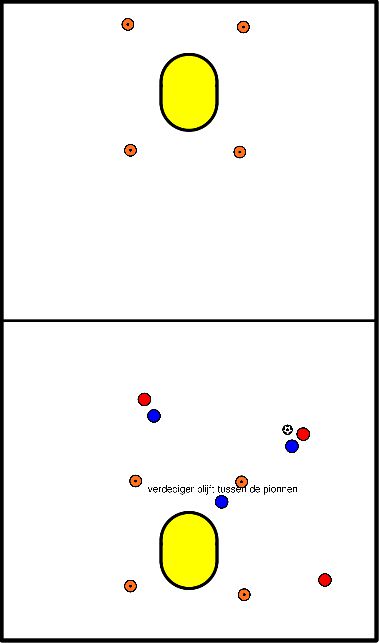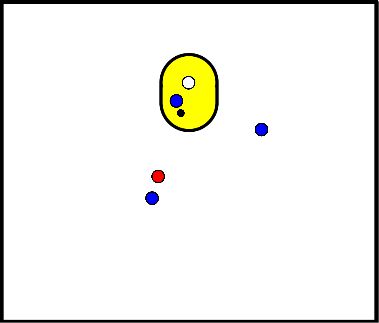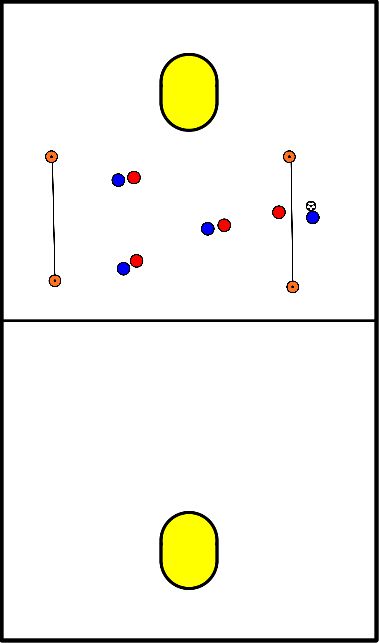Korfball drills for technique defense
- This exercise is designed to let the players choose for themselves what they want to improve on.
- Which (improvement) goal, which they have set for themselves, do they want to improve here.
- As a trainer you can steer this by guiding the choice.
- For example: the exercise must have something to do with passing/shooting/attacking/looking etc.
- 4 balls in a row, a pylon 10 metres in front of the basket, pairs with 1 ball per basket. 1 player in front of the basket with the ball near the pylon.
- (Change every goal).
- 4 posts in a square.
- 4 attackers.
- 1 attacker.
- 3 defenders.
- The attacker must find the free post.
- The defenders must therefore make it as difficult as possible and communicate.
- Variants:
- Only through balls.
- Only shots.
- x number of goals etc.

Goal: defend your own basket but score at another. Whoever remains last wins.
Minimum 3 groups of 2.
Maximum 5 groups of 3 or 4 groups of 4.
Minimum 3 groups of 2.
Maximum 5 groups of 3 or 4 groups of 4.
- Each group has a basket.
- Number of balls depends on how many groups. For example, 3 groups 2 balls.
- Make easier by fewer balls and larger groups.
Objective:
- Playing together and scoring on your own basket
- Or play together and prevent the opposing team from scoring as few goals as possible
Rules:
- Two teams in threes against each other (can also be played in fours)
- Around the basket there is a section where the defending side has a defender. The defender is only allowed to move in that section while defending. If the team is attacking, this player is allowed to join the attack. In this way there is always a surplus in the attack.
- Korfball rules are in force

1 attacker, 1 defender and 2 assistants.
- As assistants, try to pass as many balls as possible under the basket or next to the attacker without allowing the defender to interfere with the passing.
- Keep eye contact.
- Pass the attacker freely by directing non-verbally or verbally.
- Keep the ball up high to be able to play faster and better.
- Swap after 4 good chances.
Sponsors may also pass the ball between themselves to free the attacker.
The aim is always to play within shooting distance, so that every pass or action is targeted.

- 2 posts, under each post there is 1 declarator.
- In the middle stands an attacker and a defender.
- Attacker can score on both posts.
Objective:
Set up attacks in overtime situations
Rules:
- Make sure the offense always has 1 more person than the defense (3-2, 4-3, 4-2 etc.)
- Gives the offense a task:
- E.g. score within 5 passes, score after setting up an action, score from the rebound.
- Gives the defense a task:
- E.g. intercept the ball within 5 passes, defend in front.
- Decide if you can go for a defensive goal.
- Indicate with cones where the lines are.
- Agree when offense switches with defense:
- After X minutes, after X goals, after X interceptions.
- Play 4:4 and defend 1 on 1, trying to see as many fellow players as possible.
- When there is a shot you join the steal.
- In the game you take care of the catch and try to double through the outlet support.
- Run into the free space for a through ball.
Objective:
- Earn a point by catching the ball over the line.
Rules:
- A party starts from behind the line with the ball.
- Intercepted ball is ball first to your own line and then to the other side for a point.
- Balls out count.
- When a point is gained, the opponent gets the ball from there.
Points of attention:
- For defending.
- Play on the side by moving on one leg.
- Play at tempo.
- Watch each other and your opponents place.

- The ball starts under the basket and is thrown to the child in front of the basket.
- The child under the basket then runs after the ball to defend.
- It is important that the attacker is central. With too much defensive pressure, the attacker cannot practice.
- Keep moving and make sure the pass comes from the space.
- There is always room for a break-through or a shot.
- The third player takes care of the catch and plays the ball again.







